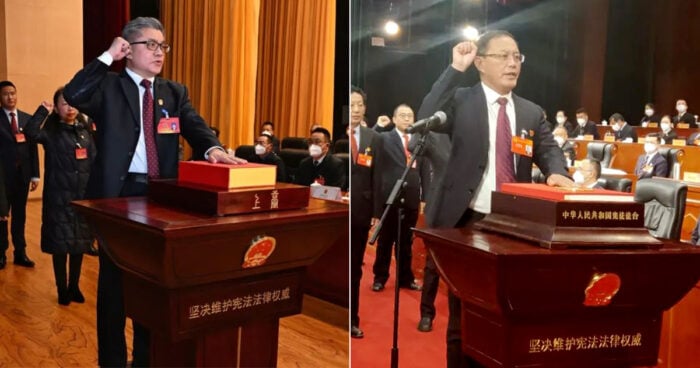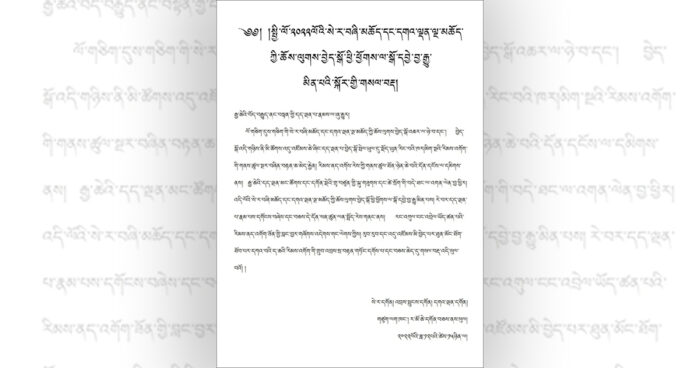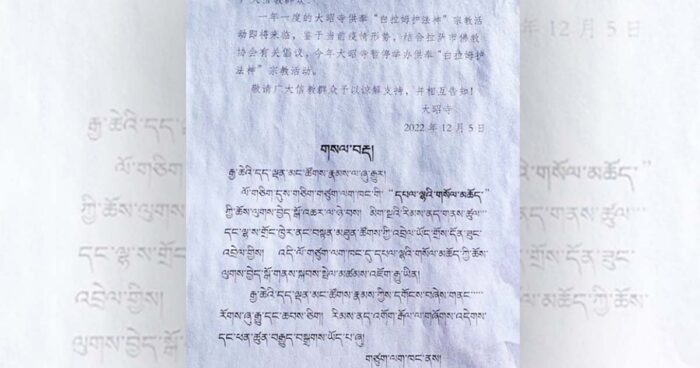The Tibetan capital city of Lhasa has a new Chinese mayor. On Dec. 13, 2022 Wang Qiang replaced Gho Khog, the Tibetan mayor of Lhasa since 2016. This change of leadership comes in the wake of the recent COVID-19 crisis in Lhasa, with similar changes seen in the mayors of Shigatse (Chinese: Rikaze) and Chamdo (Changdu), other cities in Tibet that were hit hard by COVID.
While Wang Qiang (Chinese) replaced Gho Khog (Tibetan) as the mayor of Lhasa, Wang Fanghong (Chinese) replaced Zhou Feng (Chinese) as mayor of Shigatse, and Luo Qingwu (Tibetan) replaced Chen Jun (Chinese) as mayor of Chamdo. All three new mayors were appointed on the same day.
Although Chinese propaganda depict mayors as being elected by the local legislative body, mayors in Tibet are in effect selected by the Chinese Communist Party, as the party has the final say in the selection process. Through the office of the Mayor, the CCP shapes policy and decision-making in Lhasa by influencing the budget and agenda for the local government and shaping public discourse. Mayors serve as a key link between Beijing and the local level in ensuring that Beijing’s goals and objectives are achieved within Tibetan areas. Although mayors do not make policy decisions, they have strong influence on the policymaking process and its resultant decisions.

Wang Qiang (left) and Luo Qingwu (right) take their oaths on the constitution of China (Source: Chinese state media)
Composition of the Lhasa government
With the appointment of Wang Qiang as the mayor of Lhasa, the Tibetan capital city is run almost entirely by Chinese, with a Chinese person also serving as the head of Lhasa government. The 12th People’s Congress in November 2021 announced that Gho Khog was reappointed as the Mayor with 14 Vice-Mayors. Although Gho Khog was Tibetan, 11 of the Vice-Mayors were Chinese and three were Tibetans, making the composition 79% Chinese and 21% Tibetan. With Wang Qiang replacing Gho Khog, both the head and the deputy heads of the Lhasa government are clearly commanded and controlled by Chinese, with at least six of them (three each from Beijing and Jiangsu) holding the designation of “aid-to-Tibet” cadres. Similarly, the local governments of Shigatse and Chamdo are run by Chinese with Tibetans accounting for around 30% in the leadership positions.
Between the beginning of the reform and opening era of the 1980s until Xi Jinping’s ascendency as the General Secretary of the Party in 2012, the position of Mayor of Lhasa had been held by Tibetans.
Mayors of Lhasa since 1980
| 2022 December – | Wang Qiang |
| 2016 June – 2022 December | Gho Khog |
| 2012 June – 2016 June | Zhang Yanqing (Although a Chinese name, he is reported to be a Tibetan) |
| 2006 September – 2012 December | Dorjee Tsedup |
| 2002 December – 2006 September | Norbu Dhondup |
| 1995 September – 2002 December | Lobsang Gyaltsen |
| 1992 August – 1995 June | Lobsang Dhondup |
| 1987 – 1992 | Logha |
| 1980 – 1987 | Tenpa Gyatso |
The Law on Ethnic Regional Autonomy states that the leader of an autonomous region, prefecture or county should be a member of the ethnic group that is exercising regional autonomy in the area. It also specifies that the members of the local government should include both members of the autonomous ethnic group and other ethnic minorities, if possible. However, this has not been the case in recent years, particularly since Xi Jinping came to power. One clear example of this is the appointment of Wang Qiang as Mayor of Lhasa. According to sources, the previous Mayor of Lhasa, Gho Khog, is being investigated for corruption. While Gho Khog is not well-regarded by the Tibetan community in Lhasa, the appointment of a Chinese to replace him is also not favored, according to some Tibetan sources.
More Chinese settlers in Lhasa on the horizon
With “aid-to-Tibet” cadre Wang Qiang’s appointment as the Mayor of Lhasa, Beijing is signaling plans to further “Sinicize” Lhasa by deepening the political economy in the Tibetan capital. Sinicization is a process of forcibly assimilating Tibetans and other non-Han groups and bringing them under the complete control of the Chinese government.
While most of the migrant and settler Chinese in Lhasa rushed back to their native hometowns in the Chinese heartland in late October after staging a protest against COVID policies, the current state of Lhasa as relatively free of Chinese migrants and settlers may not last for long.
Compounding this fear of more Chinese migrants and settlers coming to Lhasa after controlling COVID is the “zero-threshold” settlement policy already in effect in Lhasa since February 2022. The demography of Lhasa has undergone significant change in the past decade, which is evident comparing the 2020 census to the 2010 census. At 55% population change (with Tibetan settlers from other parts of Tibet and Chinese settlers from China) in Lhasa between the two censuses, 53% (234,986) of Chinese in the “Tibet Autonomous Region” (443,370) are settled in Lhasa according to the 2020 census. The TAR spans about half of Tibet.
The fear of more Chinese settlers in Lhasa is real. TAR Party Secretary Wang Junzheng at the CCP’s ethnic work conference in Lhasa in early February 2022 signaled deepening of bi-directional migration in the “new journey” toward a “socialist modernized new Tibet.”
The appointment of Wang Qiang in Lhasa signals deeper Chinese political control in the region. With Chinese dominating the local government and the CCP’s “zero-threshold” settlement policy already in effect, Lhasa is facing an uncertain future of more Chinese migrants and settlers in the horizon.
Restrictions on religious freedom persist in Lhasa
Since the mass protests in Chinese cities against the Communist regime and Xi Jinping over COVID policies, restrictions in Lhasa have also been relatively eased like they have in Chinese cities, although Tibetans in Lhasa live a very restricted and controlled life. However, despite the easing of COVID policies, religious freedom for Tibetans in Lhasa remains restricted.
The easing of COVID policies in Lhasa is a positive step, but it does not extend to religious freedom for Tibetans, who were prohibited from observing two important annual religious events this month. In a public notice, the authorities in Lhasa prohibited Tibetans from visiting the three great monasteries (Drepung, Sera and Ganden) and Jokhang and Ramoche temples to participate in religious ceremonies on Ganden Ngamchoe on Dec. 18. Ganden Ngamchoe is an important religious day in Tibetan Buddhism as Tibetans observe the death anniversary of Je Tsongkhapa (1357-1419, who is revered as “the crown jewel of the scholars of the land of snows,” and whose death anniversary is traditionally observed by lighting lamps and reciting prayers in memory of the great Tibetan philosopher.

Public notice prohibiting Tibetan Buddhists from observing Ganden Ngamchoe.
Similar to restricting Ganden Ngamchoe observance, authorities prohibited Tibetans from visiting and carrying out religious activity at Tibet’s holiest shrine, the Jokhang temple, for observing the Palden Lhamo festival on Dec. 7. Palden Lhamo, a wrathful female protector deity, is believed by Tibetans as the defender of Tibetan Buddhism and special protector of the Dalai Lama. Palden Lhamo festival falls on the 15th day of the 10th lunar month in the Tibetan calendar, corresponding to Dec. 7 this year.

Public notice prohibiting Tibetans from observing Palden Lhamo festival in Lhasa.
CCP deepens “Three Consciousness” campaign in monastic community
Concurrent to restricting Tibetans from observing their religious commemorative events, the authorities held a propaganda conference on Dec. 14 to deepen the “Three Consciousness” campaign in the monastic community, per the 7th Tibet Work Conference and the 20th Party Congress.
According to Chinese state propaganda, the “Three Consciousness” campaign ensures that “the monks and nuns are more closely united around the party and the government.” The Three Consciousness (national, civic and rule of law consciousnesses) campaign targets religious circles in the whole of the so-called “Tibet Autonomous Region.”

